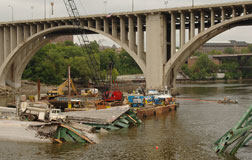 AP Clearance teams will remove steel sections more slowly than the deck. |
Although the probe of the I-35W bridge disaster in Minneapolis remains in an early stage, the National Transportation Safety Board is widening its investigation to retrofits made to the 40-year-old bridge before it collapsed on Aug. 1, killing 13.
Forensic engineers are reviewing design records and "have begun developing a list of the various construction projects and modifications that were performed to the bridge after the original construction," says NTSB in an Aug. 22 bulletin.
One of the retrofits in question involved the bridge's anti-icing equipment, a $618,450-addition that was completed in Dec., 1999. NTSB says that it also is examining "the chemical used in this system and what type of corrosive properties it might have."
The anti-icing system was designed to spray potassium acetate on the roadway to prevent "black ice," frost, frozen snow, or ice build-up, according to a July, 2001 cost-benefit review published by Minnesota Dept. of Transportation, the bridge owner.
The bridge featured 38 valve units and eight parapet spray nozzles along the longitudinally-split concrete deck. A pump house near the bridge stored 3,100 gallons of solution that was conveyed to the deck in 1-in. pressure pipe. It also had a total of 68 flush-mounted disk spray nozzles mounted in 55-ft intervals along the centerline of the northbound and southbound lanes.
The anti-ice systems constantly take readings of temperature, moisture and other environmental factors and activate at 35°F, according to Justin Bruce, vice president of New Castle, Pa.-based Boschung America LLC, which supplied the system to MNDOT.
When the system detected moisture on the bridge and a near-freezing point, it would spray about 34 gallons of solution on the roadway. The system fired once or multiple times, depending on need. Each spray unloaded about 12 gal per lane mile onto the 14-span, 1,907-ft-long bridge.
MNDOT says the "most important component" in the system is the anti-ice solution, which it purchased in bulk from another supplier, Cryotech Deicing Technology of Ft. Madison, Iowa, for about $3.25 per gal.
Cryotech sells a 50% aqueous solution of potassium acetate under the trade name CF7. Transportation agencies typically thin the solution to 25% at their own mixing stations, according to the supplier's website.
De-icing and anti-icing suppliers tout potassium acetate as biodegradable and non-corrosive. "It was the product of choice because it is safer for structural steel and reinforcing steel embedded in concrete," says MNDOT's review.
The chemical is known, however, to react negatively with zinc and brass.
MNDOT later discovered that when a chemical spill in the I-35W pump house "began to corrode a galvanized metal grate," says the 2001 cost report.
The active ingredient in galvanized coatings is zinc.
MNDOT selected the chemical and engineers did not expect it to be a problemon structural members. "None of that steel would have been galvanized. Just the guard rails, and those weren't actually deteriorated," Bruce says.
But inspection records show that the chemical reacted at least once with the bridge. The bridge was originally painted with a lead-based coating in 1968, but then in 1999 MNDOT applied a zinc-based coating to much of the span. A June, 2006 fracture-critical inspection performed by MNDOT noted "paint failure from leaking de-icing system" on one of the girders of the approach span immediately to the north of the bridge's three-span main deck truss.
The two 60-ft-deep, 988-ft-long deck trusses supported welded, 12-ft-deep, floor-beam transverse-mounted trusses and cross braces. The deck truss members were made of built-up plate boxes and rolled I-beams, and the floor trusses were made of wide-flange beams. Connections included rivets, bolts, welds and gusset plates. The system bore on four concrete piers and cantilevered approximately 38 ft at each end. Recent inspections found corrosion throughout the system, including truss members, approach girders, connection plates and bearings.
Although corrosion sources, such as rainwater and pigeon droppings, were well documented, it is unclear how extensively the anti-icing chemical could react with the bridge paint. "I don't really know the answer to that question," saysBruce.
"Potassium acetate just by its nature can have a fairly slow reaction with zinc," says Keith Johnson, president of Cryotech. "However, that in itself should not lead to any structural implications."
Dan Dorgan, Minnesota's state bridge engineer, says, "I'm not aware of that connection" between the chemical and the zinc coating. "I think anything like that would have to come out of the NTSB."
The I-35W bridge was the first of its kind to incorporate anti-icing technology in the U.S. The Boschung system is designed in Switzerland and has been used for 30 years in Europe. The company installs about five systems per year in North America.
Anti-icing systems cost an average of $500,000 to $750,000 to install and have been growing domestically as transportation agencies look to reduce maintenance costs and road wear from salt trucks. MNDOT noted in its 2001 assessment that the system on the I-35W bridge reduced vehicle crashes by 68% and paid for itself more than three times over.
The report also recommended continuing using potassium acetate because of its "environmental advantages" over sodium chloride, which the agency previously used on the Mississippi River bridge.
As for the collapse investigation, NTSB says it also has plugged I-35W structural elements into a finite-element model and is performing final software tweaks "to match the condition of the bridge the day of the accident." The Federal Highway Administration and NTSB will then run failure scenarios to determine the cause of the collapse.
Forensic officials are still removing key pieces of the bridge for examination and are developing a layout plan for partial reconstruction. An NTSB spokesman says the agency expects to remain on the scene through November.
"Additionally, investigators in Washington are sifting through materials that have already been gathered," says NTSB Chairman Mark V. Rosenker.
So far, the agency has contacted over 300 witnesses, including 25 construction workers and delivery drivers on scene the day of the collapse.
The weight of materials delivered to the bridge on Aug. 1 between 11:00 A.M. and 2:30 P.M. is confirmed at 383,000 lb. Heavy equipment raised that load to 575,000 lb.
The collapse occurred at 6:05 P.M.


Post a comment to this article
Report Abusive Comment